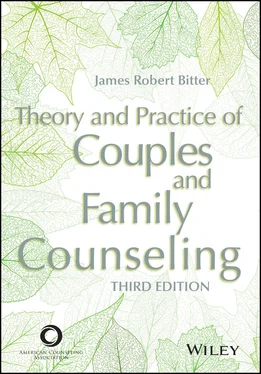James Robert Bitter - Theory and Practice of Couples and Family Counseling
Здесь есть возможность читать онлайн «James Robert Bitter - Theory and Practice of Couples and Family Counseling» — ознакомительный отрывок электронной книги совершенно бесплатно, а после прочтения отрывка купить полную версию. В некоторых случаях можно слушать аудио, скачать через торрент в формате fb2 и присутствует краткое содержание. Жанр: unrecognised, на английском языке. Описание произведения, (предисловие) а так же отзывы посетителей доступны на портале библиотеки ЛибКат.
- Название:Theory and Practice of Couples and Family Counseling
- Автор:
- Жанр:
- Год:неизвестен
- ISBN:нет данных
- Рейтинг книги:5 / 5. Голосов: 1
-
Избранное:Добавить в избранное
- Отзывы:
-
Ваша оценка:
- 100
- 1
- 2
- 3
- 4
- 5
Theory and Practice of Couples and Family Counseling: краткое содержание, описание и аннотация
Предлагаем к чтению аннотацию, описание, краткое содержание или предисловие (зависит от того, что написал сам автор книги «Theory and Practice of Couples and Family Counseling»). Если вы не нашли необходимую информацию о книге — напишите в комментариях, мы постараемся отыскать её.
Theory and Practice of Couples and Family Counseling — читать онлайн ознакомительный отрывок
Ниже представлен текст книги, разбитый по страницам. Система сохранения места последней прочитанной страницы, позволяет с удобством читать онлайн бесплатно книгу «Theory and Practice of Couples and Family Counseling», без необходимости каждый раз заново искать на чём Вы остановились. Поставьте закладку, и сможете в любой момент перейти на страницу, на которой закончили чтение.
Интервал:
Закладка:
Hanging Hats and Clearing the Mind and Heart to Focus
Virginia Satir was one of family therapy’s great models of presence when working with families. Her full focus was on the family and each of its members. Her focus was characterized by congruence and allowing the full use of her senses from seeing and hearing to touch and intuition. Her clarity of heart and mind is not something that everyone seems capable of achieving, but she always claimed it could be learned: It did not have to be innate. Here is an exercise she called Hanging Hats that she used to help people become more fully present (see Satir et al., 1991). She used this name for the exercise to emphasize the natural human tendency to proj ect internal images onto others, to hang old hats on the new people we meet. This kind of exercise is a useful step in gaining Bowen’s differentiated self.

FIGURE 3.2• A Small Segment of Jim’s Family Timeline: 1957–1961 (Ages 10–14)
Satir would start by asking those who wanted to be family practitioners to close their eyes. This was not an attempt to shut out the outside world; rather, it was a decision to focus internally. She wanted those who would help others to start with themselves, focusing on what was natural and even physical. Her first suggestion was almost always to “pay attention to your breathing; just notice that air, which gives us life, comes easily in and out of our bodies, supporting us, nurturing us, and requiring nothing beyond what is already natural for us to do.” Then she would often ask us to extend that natural function, to see what it would be like to take a little more air into the center of our bodies, and not hold it but release it easily back into the environment. To be sure, there is all sorts of evidence that this kind of breathing releases tension (Kabat-Zinn, 2005) and distress (especially the act of breathing out), but this was also just her first step in preparing counselors and therapists to be present.
She often mixed this first focus on the physical with visualizations that were designed for health, wellness, and enhancement of self-esteem (see A. Banmen & Banmen, 1991; J. Banmen & Gerber, 1985). She might ask people to visualize looking up toward the sun, and heads would almost automatically tilt upward, a physical act that we now know also tends to release individuals from feelings of fear. Within the visualization, she might wonder whether people could feel the warmth of the sun flowing over them. She might also wonder whether people could open themselves up to an appreciation of changes that being in the sun brings to one’s life, bringing all of the value of the sun into the very center of their being. And could we appreciate ourselves for all that we had been through to become the people that we had become, an acceptance of who we were as human beings? Satir would often suggest that this was preparation for becoming more fully human: “Very little change goes on without the patient and therapist becoming vulnerable” (M. Baldwin & Satir, 1987, p. 22).
When people, listening to her voice, were centered in rest, their heart rates slowed and their breathing calm, she would ask them to open their eyes and look at the people with them, perhaps an individual, a couple, or a family. Satir would often have participants in triads, which she considered the basic unit of the family. She would ask people to use their eyes to take a picture of each person in front of them, placing the pictures on the otherwise blank screen in the participants’ minds. Then she might suggest that participants go back inside themselves, letting any other picture from the family practitioner’s past or present come forward, placing it on the mind’s screen right next to the initial pictures. All sorts of questions might arise from this experience: Whose picture came forward? What relationship did the person in the picture have to the family counselor or therapist? How did the family practitioner feel about the person who came to mind? What issues, if any, still existed between the family practitioner and the person who came to mind in this process? Each of these questions was important in its own right, but they also helped to clarify and answer a larger question: Who was the family practitioner having the pleasure of meeting: the person, couple, or family, or pictures the counselor was about to associate (impose) on the clients?
Satir would then ask people to open their eyes once more and really look at the people with whom they were sitting. What did people notice about others? What part of every other person stood out? What meaning did the person associate with a chosen part or trait? Here is a processing that involved me when I attended a Satir conference in 1979:
Satir: Okay, Jim has curly hair, and you notice it: What do you think about curly hair?
Participant: It’s soft.
Satir: And what meaning do you associate with softness?
Participant: I feel that he is probably kind.
Satir: Now isn’t that interesting: There’s a bit of a leap there from softness to kindness, isn’t there? [turning to me] And are you kind?
Jim: I try to be.
Satir: And sometimes are you also grumpy and not in the mood to be kind?
Jim: Yes.
Satir: But you have curly hair: Isn’t that a permanent contract for unlimited kindness?
Virginia knew that everything we notice is meaningful. If we attend to something, we attach meaning to it. Our only choice is whether we will be conscious (aware) of the meanings we are making or not. Projection (seeing ourselves in others), of course, goes hand in hand with introjection (or an internalization of others), so Satir would often ask family practitioners to imagine what observers thought would stand out in them. That is, what do you think stands out to others in you, and what meaning do you think they attach to it? What is it like to have this fantasy about yourself? How does your body respond? How do you wind up feeling?
Satir was also interested in what our first experiences with each other were. First impressions are hard to change, so taking time to reflect on our first impressions is an important step in defusing their power and becoming present. Let us say that my first impression of you is that you are a bright, intelligent, interesting person whose company I enjoyed, but the next time I see you, you seem lost, distracted, and not very coherent. Rather than change my mind about you, I am likely to say that you are not having a very good day: My first impression still holds. If you are distracted and incoherent again, I might still say, “Wow! Two bad days in a row.” It is not until the third similar experience that I actually decide my first impression was mistaken. Now, if it takes me three new experiences to change a positive first impression, what is going to happen with a negative first impression? It is very likely that it will be so strong that I will not even give you a chance for a second impression. Reflecting on first impressions allows us to set our expectations aside and see whom we are really with at this time in this space.
Finally, Satir would ask us to remember any third-party information we had about the people we were meeting—any gossip or rumors we had heard about the people with whom we were about to make contact. In clinical and school settings, this often includes information that is part of the files kept on individuals, couples, or families. It is a far different thing to meet people as they are than to meet “a schizophrenic,” “a failing child with attention-deficit/hyperactivity disorder,” or “a batterer.” Labels, as we shall see, carry a lot of power, and one of the great misuses of this power is to eliminate the real person or people sitting right in front of us.
Читать дальшеИнтервал:
Закладка:
Похожие книги на «Theory and Practice of Couples and Family Counseling»
Представляем Вашему вниманию похожие книги на «Theory and Practice of Couples and Family Counseling» списком для выбора. Мы отобрали схожую по названию и смыслу литературу в надежде предоставить читателям больше вариантов отыскать новые, интересные, ещё непрочитанные произведения.
Обсуждение, отзывы о книге «Theory and Practice of Couples and Family Counseling» и просто собственные мнения читателей. Оставьте ваши комментарии, напишите, что Вы думаете о произведении, его смысле или главных героях. Укажите что конкретно понравилось, а что нет, и почему Вы так считаете.












